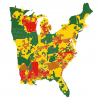You're better at recordkeeping than MN is, in any case - and I agree that Pope and Young is pretty clearly the better yardstick to use, if you're after antlers. Given the amount of harvest that states like MN and WI cram into even just opening day and for sure into firearms seasons, and how the regional data averages out (which I imagine smooths out at least some of the sampling oddities, although there can certainly be regional differences as well).
What I can say is that, high-ish deer numbers and high-ish average hunter success (even if the average SE hunter spends 50% more days afield per
older QDMA data - they're also taking almost double the bucks/hunter vs. the midwest) with more diffuse hunting pressure and liberal bag limits is definitely a different dynamic than the concentrated pressure, lower overall success, and stricter harvest limits of the midwest.
The average SE hunter spending more days afield, with less of a clock counting down, seems more likely (to me) to have the average joe hunting more selectively than an orange army free-for-all. But I have very little feel for how the occasional, few-times-a-year, southern hunter would operate.
Also interesting to look at are the data on either side of the MN/WI border. definitely some of that is a diiference in landscape that happens to track with the border, but also differences in management. Probably some recordkeeping differences too. Similar to the AL/MS thing only more so and with bigger deer.
View attachment 52997





